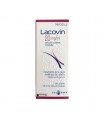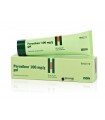It is a topical anesthetic that works by suppressing pain when applied externally, over the area of the mouth to be treated.
This medicine is used for symptomatic relief of mouth, tooth, tooth and gum pains until they can be adequately cared for by the dentist in adults and children over 2 years of age.
You should see a doctor if it gets worse or if it does not improve after 2 days of treatment.
1. What is Dentispray and what is it used for?
It is a topical anesthetic that acts by suppressing pain when applied externally, on the area of the mouth to be treated.
This medicine is used for the symptomatic relief of pain in the mouth, toothaches, teeth and gums until they can be adequately treated by the dentist in adults and children over 2 years of age.
You must talk to a doctor if you do not feel better or if you feel worse after 2 days of treatment.
2. What you need to know before you start using Dentispray
Do not use Dentispray
If you are allergic to benzocaine, other local anesthetics derived from para-aminobenzoic acid or any of the other ingredients of this medicine (listed in section 6).
Warnings and cautions
Consult your doctor or pharmacist before using Dentispray.
- If you cannot tolerate other local anesthetics such as para-aminobenzoic acid (PABA), parabens, or paraphenylenediamine (a component of hair dye).
- If you have a serious or extensive injury to your mouth.
- Do not take doses higher than that recommended in section 3 (How to use Dentispray).
- Sick or debilitated older people should consult their doctor before using this medicine as they are more sensitive to its possible adverse reactions.
- Avoid spraying into the eyes.
- Do not inhale or ingest.
- You should not eat or drink while the numbness in your mouth persists, due to the risk of biting your tongue or oral mucosa and choking.
- Keep away from fire or flame. Do not smoke during application.
Using Dentispray with other medicines
Tell your doctor or pharmacist if you are using, have recently used or might take any other medicines.
This medicine can interact with:
- Sulfamides (medicine to treat infections): should not be used at the same time as benzocaine, as it can decrease the antibacterial effect of sulfonamides.
- Medicines containing hyaluronidase: should not be used at the same time as benzocaine, as it can increase the adverse effects of benzocaine.
- Other local anesthetics.
- In people sensitive to benzocaine, paraphenylenediamine-type hair dyes can cause severe contact dermatitis.
Using Dentispray with food and drink
Do not use this medicine before meals or before drinking (see section Warnings and precautions).
Pregnancy and breastfeeding
If you are pregnant or breast-feeding, think you might be pregnant or are planning to become pregnant, consult your doctor or pharmacist before using this medicine.
You should not use benzocaine during pregnancy.
It is not known whether benzocaine is excreted in human milk, so breast-feeding women should not use this medicine.
Driving and using machines
The influence of this medicine on the ability to drive and use machines is zero or negligible.
3. How to use Dentispray
Follow exactly the instructions for administration of the medicine contained in this leaflet or those indicated by your doctor or pharmacist. If in doubt, ask your doctor or pharmacist.
The recommended dose is:
- Adults and adolescents
1 app. Apply to the area to be treated 3 or 4 times a day. It should not be applied more than 4 times a day.
Each press is equivalent to approximately 3 mg of benzocaine.
- Use in children
Children 6-12 years : only under the supervision of an adult, apply as in the previous case.
Children 2-6 years : under control doctor.
Children under 2 years : under strict control doctor.
Form of administration
This medicine is to be given by mouth.
Do not inhale or ingest.
Uncap the bottle and place the button, with the incorporated applicator cannula, on the outlet tube of the dosing pump. Press the button several times until the pump is filled. The medicine can then be applied, either directly by pressing the button and directing the solution outlet with the cannula towards the painful area, or by soaking a cotton ball with several pulses and keeping it applied to the area for a short period of time. Once the treatment is finished, it is recommended to rinse the cannula with water, dry it and store it.
If symptoms worsen or persist after 2 days of treatment, you should see your dentist.
If you use more Dentispray than you should
Signs of overdose may be: bluish discoloration of the skin, slurred speech, numbness, wobbly gait, blurred or double vision, dizziness, excitement or seizures, ringing of the ears, increased sweating. It can also lower blood pressure.
In case of overdose or accidental ingestion, immediately consult a doctor or go to a medical center or call the Toxicology Information Service (telephone 91 562 04 20), indicating the medicine and the amount ingested.
4. Possible side effects
Like all medicines, this medicine can cause side effects, although not everyone gets them.
During the period of use of benzocaine, the following adverse effects have occurred, the frequency of which has not been established with precision:
Urticaria, edema, anaphylactoid reaction (contact dermatitis). Cross reactions with other ester type local anesthetics. Photosensitivity, bad taste in the mouth, dehydration of the mucous membranes and swallowing difficulties.
Mouth burning sensation.
Methemoglobinemia whose symptoms are: headache, dizziness, shallow breathing, nausea, fatigue or rapid heartbeat.
Prolonged contact of benzocaine with the mucous membranes of the mouth can cause dehydration of the epithelium and hardening of the mucous membranes of the mouth.
Communication of adverse effects
If you experience any kind of side effect, consult your doctor or pharmacist, even if it is about possible side effects that are not listed in this leaflet. You can also communicate them directly through the Spanish Pharmacovigilance System for Medicines for Human Use website: www.notificaram.es.
By reporting side effects you can help provide more information on the safety of this medicine.
5. How to store Dentispray
Keep this medicine out of the sight and reach of children.
It does not require any special storage conditions.
Do not use this medicine after the expiry date which is stated on the carton and carton after EXP. The expiration date is the last day of the month indicated.
Medicines must not be disposed of via wastewater or household waste. Deposit the containers and medicines that you do not need at the SIGRE Point of the pharmacy. If in doubt, ask your pharmacist how to dispose of medicines no longer required. This way you will help to protect the environment.
6. Package contents and additional information
Composition of Dentispray
- The active substance is benzocaine. Each milliliter of dental solution contains 50 mg of benzocaine.
- The other ingredients (excipients) are: polyethylene glycol 400, purified water, sodium saccharin, thymol, menthol, peppermint essence, disodium phosphate dodecahydrate and 96º ethanol.
What the product looks like and contents of the pack
Dentispray is presented in aluminum bottles of 5 ml of dental solution, with a dosing pump and a push button with the incorporated applicator cannula. The solution is a clear, colorless liquid with a characteristic odor.
Holder of the marketing authorization and responsible for manufacturing
Laboratorios Viñas , SA
Provence, 386
08025- Barcelona
Date of last revision of this leaflet: May 2014
Detailed and updated information on this drug is available on the website of the Spanish Agency for Medicines and Health Products (AEMPS) http://www.aemps.gob.es/



































